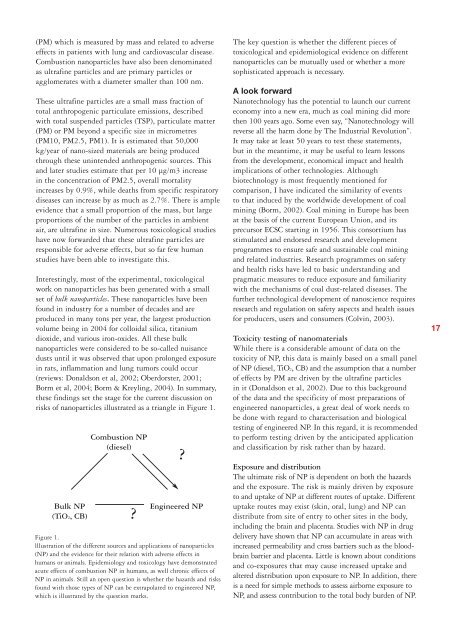Small size - large impact - Nanowerk
Small size - large impact - Nanowerk
Small size - large impact - Nanowerk
Create successful ePaper yourself
Turn your PDF publications into a flip-book with our unique Google optimized e-Paper software.
(PM) which is measured by mass and related to adverse<br />
effects in patients with lung and cardiovascular disease.<br />
Combustion nanoparticles have also been denominated<br />
as ultrafine particles and are primary particles or<br />
agglomerates with a diameter smaller than 100 nm.<br />
These ultrafine particles are a small mass fraction of<br />
total anthropogenic particulate emissions, described<br />
with total suspended particles (TSP), particulate matter<br />
(PM) or PM beyond a specific <strong>size</strong> in micrometres<br />
(PM10, PM2.5, PM1). It is estimated that 50,000<br />
kg/year of nano-<strong>size</strong>d materials are being produced<br />
through these unintended anthropogenic sources. This<br />
and later studies estimate that per 10 µg/m3 increase<br />
in the concentration of PM2.5, overall mortality<br />
increases by 0.9%, while deaths from specific respiratory<br />
diseases can increase by as much as 2.7%. There is ample<br />
evidence that a small proportion of the mass, but <strong>large</strong><br />
proportions of the number of the particles in ambient<br />
air, are ultrafine in <strong>size</strong>. Numerous toxicological studies<br />
have now forwarded that these ultrafine particles are<br />
responsible for adverse effects, but so far few human<br />
studies have been able to investigate this.<br />
Interestingly, most of the experimental, toxicological<br />
work on nanoparticles has been generated with a small<br />
set of bulk nanoparticles. These nanoparticles have been<br />
found in industry for a number of decades and are<br />
produced in many tons per year, the <strong>large</strong>st production<br />
volume being in 2004 for colloidal silica, titanium<br />
dioxide, and various iron-oxides. All these bulk<br />
nanoparticles were considered to be so-called nuisance<br />
dusts until it was observed that upon prolonged exposure<br />
in rats, inflammation and lung tumors could occur<br />
(reviews: Donaldson et al, 2002; Oberdorster, 2001;<br />
Borm et al, 2004; Borm & Kreyling, 2004). In summary,<br />
these findings set the stage for the current discussion on<br />
risks of nanoparticles illustrated as a triangle in Figure 1.<br />
Bulk NP<br />
(TiO2, CB)<br />
Combustion NP<br />
(diesel)<br />
?<br />
Engineered NP<br />
Figure 1.<br />
lllustration of the different sources and applications of nanoparticles<br />
(NP) and the evidence for their relation with adverse effects in<br />
humans or animals. Epidemiology and toxicology have demonstrated<br />
acute effects of combustion NP in humans, as well chronic effects of<br />
NP in animals. Still an open question is whether the hazards and risks<br />
found with those types of NP can be extrapolated to engineered NP,<br />
which is illustrated by the question marks.<br />
?<br />
The key question is whether the different pieces of<br />
toxicological and epidemiological evidence on different<br />
nanoparticles can be mutually used or whether a more<br />
sophisticated approach is necessary.<br />
A look forward<br />
Nanotechnology has the potential to launch our current<br />
economy into a new era, much as coal mining did more<br />
then 100 years ago. Some even say, “Nanotechnology will<br />
reverse all the harm done by The Industrial Revolution”.<br />
It may take at least 50 years to test these statements,<br />
but in the meantime, it may be useful to learn lessons<br />
from the development, economical <strong>impact</strong> and health<br />
implications of other technologies. Although<br />
biotechnology is most frequently mentioned for<br />
comparison, I have indicated the similarity of events<br />
to that induced by the worldwide development of coal<br />
mining (Borm, 2002). Coal mining in Europe has been<br />
at the basis of the current European Union, and its<br />
precursor ECSC starting in 1956. This consortium has<br />
stimulated and endorsed research and development<br />
programmes to ensure safe and sustainable coal mining<br />
and related industries. Research programmes on safety<br />
and health risks have led to basic understanding and<br />
pragmatic measures to reduce exposure and familiarity<br />
with the mechanisms of coal dust-related diseases. The<br />
further technological development of nanoscience requires<br />
research and regulation on safety aspects and health issues<br />
for producers, users and consumers (Colvin, 2003).<br />
Toxicity testing of nanomaterials<br />
While there is a considerable amount of data on the<br />
toxicity of NP, this data is mainly based on a small panel<br />
of NP (diesel, TiO2, CB) and the assumption that a number<br />
of effects by PM are driven by the ultrafine particles<br />
in it (Donaldson et al, 2002). Due to this background<br />
of the data and the specificity of most preparations of<br />
engineered nanoparticles, a great deal of work needs to<br />
be done with regard to characterisation and biological<br />
testing of engineered NP. In this regard, it is recommended<br />
to perform testing driven by the anticipated application<br />
and classification by risk rather than by hazard.<br />
Exposure and distribution<br />
The ultimate risk of NP is dependent on both the hazards<br />
and the exposure. The risk is mainly driven by exposure<br />
to and uptake of NP at different routes of uptake. Different<br />
uptake routes may exist (skin, oral, lung) and NP can<br />
distribute from site of entry to other sites in the body,<br />
including the brain and placenta. Studies with NP in drug<br />
delivery have shown that NP can accumulate in areas with<br />
increased permeability and cross barriers such as the bloodbrain<br />
barrier and placenta. Little is known about conditions<br />
and co-exposures that may cause increased uptake and<br />
altered distribution upon exposure to NP. In addition, there<br />
is a need for simple methods to assess airborne exposure to<br />
NP, and assess contribution to the total body burden of NP.<br />
17
















